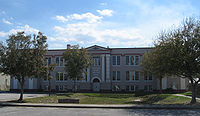Melbourne High School
Best in US – International Kudos
By Diane Barile, South Brevard Historical Society
Space Age rockets lifting off from Cape Canaveral brought focus on the coast of Florida but so did the little Melbourne High School on the Indian River Lagoon. The 1960’s acclaimed as one of the best high schools the country and noted internationally, the school was as revolutionary in the 1950’s as putting a man on the moon.
A policy of no grade level assignments and a precedent setting curriculum by the 1952 new principal. B. Frank Brown changed secondary school education not only in Melbourne but nationally. The irrepressible Brown bragged that the library was bigger than the gym and the school auditorium served the whole community. Brown’s aim was “to meet the imaginative nature of young people strengthened by discipline,” a varied curriculum was tailored for nontraditional students with higher mathematics, languages like Chinese and Hebrew, and sciences from biology to advanced physics. Each class was designed to meet the particular abilities of each student.
Media coverage worldwide from TV, newspapers, and major magazines like Time Magazine caught the attention of the founders of the Radiation, Inc. (now L3 Harris). Chairman Joe Boyd recalled the electronics company chose to locate in Melbourne because superior schools were essential in attracting, for hire, the highly trained engineers and scientists vital to the emerging space age.
Education for some time had been the hallmark in the development of South Brevard County. The pioneering Goode family donated land and neighbors helped build the tiny first school on the lagoon bluff in 1883. The four to five month term was taught by the daughters of the most educated of local families. The class of six or seven white children attended in the morning. Black children, sons and daughters of former slaves attended in the afternoon. This little red school house is preserved today in the Florida Tech Gardens.
- T. Wells, of Green Gables, a major Melbourne investor in 1897 opened the first high school in Melbourne. It closed by 1900 because there were no more students.
With school tax money an impressively large school was built in 1919 for grades 1 – 12 during the buildup of the Florida Land boom. From 1920 until 1925 the Melbourne population grew from 533 to nearly 3000. The new school was so crowded that temporary buildings housed the influx of students.
Now there was a need for a “newer” new school. From 1923 until 1925 high school enrollment climbed from 93 to 233. The need for a separate school brought approval of a special tax to fund the first free standing Melbourne High School.
County schools were consolidated with school busses bringing high school students from as far south as Grant to the “beautiful airy modern school” on Melbourne’s New Haven Avenue.
While the population of Melbourne declined during the Great Depression of the 1930s the school became a center for community life. Dedicated teachers taught on, sometimes without pay, to serve the needs of their students. Principal Ruth Henegar held things together with educators like Bessy Reeves, who inspired children for decades.
Some students at Mel High were indeed airmen assigned to local bases during World War II. Some who trained here, married local girls and returned, service completed, to establish their own homes. Ergo, another housing boom and more students. The latest “new” Melbourne High School built on Babcock Street still operates with children whose fathers, mothers and grandparents hallowed the halls of the most “modern” designed school of the 1950s. The legacy of Dr. B. Frank Brown reflects in the accomplishment of the students in science, athletics and music.
The community committed to secure the best education possible for their children invested for years in innovative building by design, top-notch teachers, and the reputation for excellence in instruction methods. These assets have imprinted on generations of students who have contributed ability to our town but also the spirit of our country.


Recent Comments